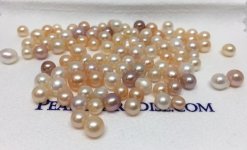jshepherd
Pearl Paradise
- Joined
- Jun 22, 2004
- Messages
- 6,305
While in Hong Kong last week there was quite a bit of talk about a new kind of freshwater pearl being grown. It's still in the experimental stage, but they have succeeded in producing a small amount. Commercial production won't be available until late 2018, but this very likely could be a game changer for smaller freshwater pearls.
These pearls are are a sample of what is to come. They are small - none are larger than 7 mm. They are "raw material," which means they are straight out of the shell. They've had no processing done to them whatsoever.
But who can guess what makes them so special? I think someone here should be able to figure it out.

These pearls are are a sample of what is to come. They are small - none are larger than 7 mm. They are "raw material," which means they are straight out of the shell. They've had no processing done to them whatsoever.
But who can guess what makes them so special? I think someone here should be able to figure it out.


